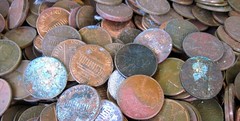
PREV ARTICLE
NEXT ARTICLE
FULL ISSUE
PREV FULL ISSUE
THE PROBABILITIES OF PENNIESBill Eckberg writes: The following link appeared on the National Science Foundation's Science 360 News Service daily email today. It is apparently not difficult to put together a date set of Lincoln Memorial cents. www.wired.com/wiredscience/2012/02/the-probabilities-of-pennies/ . Science 360 is available free to anyone. Tuesday's entire page is available at news.science360.gov/archives/20120207 . Coin-related material appears occasionally.
Thanks - I had seen this item from Wired magazine, too. Here's an excerpt.
-Editor
Back in 1999, Shiyong Lu, now at Wayne State University, and Steven Skiena, at SUNY Stonybrook, set out to calculate this. They began by recognizing that the probabilities of finding different coins are not equal. The probability of finding a coin from a given year is dependent on its mintage—how many coins of that type were issued that year—how long the coin has been in circulation, and something called collector pressure. The higher the mintage, the higher the probability of finding a coin. However, the higher the age, the lower the chances, because coins get taken out of circulation due to getting lost, whether behind furniture or otherwise. Collector pressure, the final factor, refers to how much collectors try to find a given coin. The higher the collector pressure, the lower the chance of finding that coin, because other collectors are trying to also obtain it and are taking it out of circulation. For pennies, if you look at coins only from 1959 or newer, the year when wheat pennies were replaced with pennies with the Lincoln Memorial that most of us are familiar with, we can eliminate the difficulty of dealing with collector pressure. So Lu and Skiena set out to calculate the number of pennies needed to collect before they received a complete set of pennies from 1959 to 1997. Running the numbers, Lu and Skiena found that 684 pennies must be collected in order to get one from every year. When they tried this, they got all years from 1959 to 1997 in only 630 coins, not too far from what was expected!
To read the complete article, see:
The Probabilities of Pennies
(www.wired.com/wiredscience/2012/02/the-probabilities-of-pennies/)
The Numismatic Bibliomania Society is a non-profit organization promoting numismatic literature. See our web site at coinbooks.org. To submit items for publication in The E-Sylum, write to the Editor at this address: whomren@gmail.com To subscribe go to: https://my.binhost.com/lists/listinfo/esylum All Rights Reserved. NBS Home Page Contact the NBS webmaster 
|
